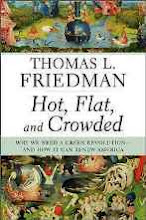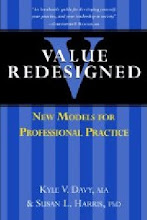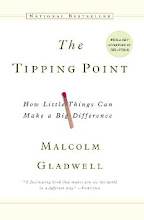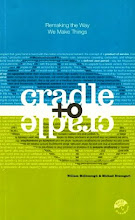 “The goal of life is living in agreement with nature.”Zeno (335 BC-264 BC)
“The goal of life is living in agreement with nature.”Zeno (335 BC-264 BC) Sustainability is on the minds of every industry as the green movement has reached a critical mass. In the short time frame of fifteen years, green architecture and sustainable technologies have evolved from a radical fringe of ardent supporters to a generally accepted public mandate that is revolutionizing the entire world economy. Below the surface is a monumental shift in corporate thinking which is refining this brave new green world. Every industry will be challenged to make the shift to a new paradigm in order to prosper or even survive. The landscape and nursery industry has always been in the center of the green movement, but is not generally perceived as a leader which consistently brings innovation to the table. There can be no denying the magnitude of the sustainability movement as it becomes increasing codified in our daily life. The time is fast approaching for the landscape and nursery industry to assess its future and decide to either sink or swim in the mounting green wave. The commitment to become leaders in the sustainability movement will require dedication and innovation from both individual businesses as well as trade organizations.
The first question that arises is “
what does it mean to be green?” Unfortunately, there are no publicly established policies or guidelines which are definitive, but rather a series of sometimes vague and confusing principals. Being green is easiest described as a way of thinking, in that every action shall do no wrong or diminish the earth’s resources for future generations. The difficult part is that every industry will be required to define these sustainable principals for their specific industry. Be assured that this process will not be simple and the rules will constantly change, but every industry will struggle in defining its role in the new green economy.
The origins of this green tidal wave can be traced back to a single document. In 1992, the City of Hanover, Germany hired architect William McDonough to craft a series of environmental principals to guide architects and planners in the development of exhibits for the 2000 World Expo to be held in Hanover. This short list of environmental goals came to be known as the Hanover Principals. Although over the years these sustainable principals have been expanded, interpreted, defined and debated, they are still the fundamental foundation of the sustainability movement.
As other industries begin to define their role in sustainability, they contribute useful tools which can help the landscape and nursery industry to find its way. Places to look for current thinking and valuable information include the United States Green Building Council (USGBC) www.usgbc.org, which has established the Leadership in Energy and Environmental Design (LEED) green building rating system. The American Society of Landscape Architects (ASLA) www.asla.org has established a strategic partnership with a number of environmental organizations called the Sustainable Site Initiative www.sustainablesites.org to establish a green site rating system for individual sites. There are a number of organizations such as “Cradle to Cradle Certification” www.mbdc.com/certified.html, which helps customers purchase and specify products that are pursuing a broader definition of quality environmentally-intelligent design. Industry specific guides are emerging such as the Certified Forest Products Council (CFPC) www.certifiedwood.org which provides information about sustainable forestry, and includes a directory of sustainably harvested lumber.
Although these organizations provide some insight in how sustainability is interrupted by other associations, none of the documents will address in detail the needs for the landscape and nursery industry. This will come from within the industry as we begin to look critically at the opportunities for changing traditional practices and replacing them with more environmentally friendly business practices. The initial areas for consideration are easy to identify such as business practices that negatively impact air quality, water quality, biodiversity and consumption of natural resources. Let’s look at each of these four simple opportunities in more detail as they might relate to traditional industry practices, knowing that there are dozens of other subjects that should be considered in mainstreaming sustainability into every aspect of the landscape and nursery industry.
Air QualityWith the emissions from operating and refueling of landscape equipment, vehicles have a significant impact on air quality. Small gasoline-powered engines often produce much greater levels of pollution than that of a full sized car per hour of operation. The estimates can be as much as 1000 times more emissions are produced from small gasoline-powered engines. When these engines are mistuned, or run without air filters, measurements show as much as 50% of the fuel exhausted as unburned hydrocarbons. The EPA estimates that as much as 5% of urban air pollution can be linked to their usage. Considering the entire carbon footprint of the landscape and nursery industry, the consequences are significant.
A sustainable approach would minimize air pollution by investing in hybrid or fossil free vehicle fleets as well as a mileage optimization on how those fleets are deployed each day. Small gas-powered engines can be replaced with electric powered equipment. While electric still has environmental impacts primarily in the manufacturing process, the total embodied energy used during the equipment’s life cycle cost is much less. The most environmentally friendly grounds maintenance equipment is human powered which does not rely on a power source. I believe there could be an emerging niche in the market for a premium priced high sustainability ground maintenance service.
Water QualityThe landscape and nursery industry applies a vast amount of chemical based pesticides and fertilizers which, even with the best management practices, are subject to leaching into stream ways and water courses. While monumental progress has been made in training grounds staff in the proper calibration and application of the chemicals, it does illustrate the industry’s reliance on preventative chemical use instead of prescriptive treatment of diseases. An enlightened chemical approach which reduces generic broad based preventative treatments in favor of selective targeted solutions would shift the chemical industry’s investment toward development of new softer solutions. A serious discussion in the landscape industry needs to challenge the reliance on traditional chemical approaches and foster greater acceptance of ecological based approaches.
The greatest impact the landscape and nursery industry has on water quality is in the management of construction activities through the primary responsibility for erosion control. Our experience indicates the landscape industry is only marginally engaged in erosion control. No other trade has a greater opportunity to express leadership in managing water quality during site grading and establishment of vegetation. This industry should be the foremost advocate and expert in site erosion control implementation. Accepting responsibility for the site can expand revenues for forward thinking companies.
With the increased development of suburban areas, more frequent and pronounced flooding has occured. This not only results in erosion, stream pollution, and destruction of aquatic habitat, but tremendous property damage and loss of human lives. Several compelling best management practices exist that the industry can use to help to reduce flooding and reuse a precious natural resource. These stormwater based solutions such as rain harvesting, rain gardens, green roofs and bioswales, while not new have garnered a new wave of public interest. The best thing about these stormwater technologies is that they easily fall into the traditional market of the industry. A concerted effort in promoting integrated stormwater solutions within the industry would represent another leadership position the industry could assume.
Declining BiodiversityThe world's biodiversity is declining at an unprecedented rate, with current extinction rates that are at least 900 times higher than natural rates found in the fossil record. Over 15,000 plant and animal species are now considered at risk of extinction representing an increase of 3,330 species since 2003. The landscape and nursery industry may contribute more to declining biodiversity than it does in preventing it. Consider the impacts of introduction of invasive plants into the landscape, clearing land, establishment of lawns, planting too few species that benefit wildlife, overuse of pesticides and dominant use of limited varieties of plants like Bradford pears and junipers.
When non-native plants "escape" from our landscape and take over natural areas they choke out the wide variety of native plants on which wildlife depends. Our desire for large lawn lots results in significant clearance of natural areas which fragments wildlife habitat. While less than 10% of all insects are harmful to plants, most pesticides are harmful or lethal to all insects. The industry maintains a dominant focus on horticultural planting strategies instead of advocating more complex ecological based plantings. We have become our own worst enemy in perpetuating traditional solutions as the basis of most designs.
A dramatic shift in conventional thinking is necessary to address sustainability in the core of the landscape and nursery industry. The industry needs to develop viable solutions to lawns and corporate landscapes in favor of diverse ecological natural communities which value biodiversity. We need to shift the basis of the green economy from low skilled lawn maintenance labor to more technically knowledgeable resource managers. Along with this paradigm shift comes increased market value and revenue opportunities. The need for biodiversity can be a catalyst in reforming traditional practices into a sustainable future.
Consumption of Natural ResourcesThe world only has a limited supply of natural resources and consumption rates are increasing. The United States is the world's largest consumer in absolute terms for many resources, eleven of the top twenty. Opportunities for using less are limitless when we look at our consumer economy. Principles for reducing consumption of natural resources can be applied to every aspect of business when you look at areas like packaging, recycling, specifying locally produced goods and use of low environmental impact materials.
Looking specifically at the landscape and nursery industry, specific opportunities emerge when we focus on business operations such as reducing fuel for landscape equipment, conserving water when irrigating plants, mitigating soil lost through erosion and eliminating peat moss or other harvested organic materials to amend soils. The green industry is indirectly responsible for 30% of water consumption in urban areas in the eastern United States for watering lawns, and in the West this figure is 60%. Guidelines for reduction or elimination of irrigation water are commonly available, but the environmental ethics need to be embraced by the entire industry. The green industry can be a powerful advocate in promoting sustainable solutions.
The world is shifting towards an environmental paradigm which fundamentally changes how we conduct every aspect of our lives. This green wave of change is upon us and it is our decision to sink or swim. We can allow the wave to overwhelm the industry or we can choose to participate as leaders riding the wave to a prosperous future of limitless opportunities. The future will be best defined for our industry internally by creative, innovative professions who have a passion for environmental change and civic commitment. By embracing the challenges to redefine our businesses practices at the most basis levels the industry will be guaranteed a meaningful front row seat in the new green economy. There is a lot of work to be done and a short amount of time available, so let’s get started in building a new green foundation for the future.
“Do not go where the path may lead, go instead where there is no path and leave a trail.”
Ralph Waldo Emerson


















































